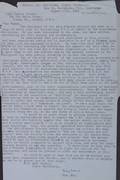Activists organise
Throughout 1957 publicity about the Western Australian report was kept alive by activists who exploited the film, and the sense of public outrage it generated, for specific ends. The London-based Anti-Slavery Society had informed the Victorian Council for Aboriginal Rights in 1956 of its intention to bring the issue of Australia's treatment of its Aboriginal people before the United Nations. The Victorian Council and the New South Wales Aboriginal-Australian Fellowship, which formed that year, were in contact with Lady Jessie Street, a committee member of the Anti-Slavery Society. She urged activists to form a federal body which could assist in the preparation of the Anti-Slavery Society's case to the United Nations. Shirley Andrews, Secretary of the Council for Aboriginal Rights wrote to Jessie Street about this matter.
Underlying the Warburton Ranges controversy was the question of whether the state or the Commonwealth governments (or both) were morally and financially responsible for impoverished and dispossessed Aboriginal people. Anna Vroland, Secretary of the Melbourne branch of the Women's International League for Peace and Freedom, kept in contact with her London counterparts. She urged cooperation and pointed out that the establishment of the British atomic testing project in the Australian desert was at the expense of those still living as hunter-gatherers. The responsibility for the disruption to people's lives, she argued, lay with all of the governments involved. The Western Australian government requested federal funds to implement the recommendations of the Grayden Report, but the federal government refused, maintaining that the matter was a state responsibility.
Referendum petition launched
On 29 April 1957, the Aboriginal-Australian Fellowship showed the Warburton Ranges film to a packed Sydney Town Hall meeting and a petition was launched for a referendum to make Aboriginal affairs a federal responsibility. More than 1500 attended the meeting at which Aboriginal spokesmen Bill Onus, President of the Australian Aborigines League, Bert Groves, president of the Aboriginal-Australian Fellowship, and Harold Blair, a famous singer, all spoke. In Melbourne the hastily formed 'Save the Aborigines' body was wound up, and the Victorian Aborigines' Advancement League was formed with Doug Nicholls, Gordon Bryant, Stan Davey and Doris Blackburn at the helm.
Tribune reports launch of the Aboriginal-Australian Fellowship petition, 1 May 1957
Source: Tribune, 1 May 1957
More info on Tribune reports launch of the Aboriginal-Australian Fellowship petition, 1 May 1957
Lady Jessie Street, an experienced international activist, wrote of the 'psychological moment' having come, a time when, if activists were skilful, they could build upon community response and maintain momentum in the work for what was called 'Aboriginal advancement'. In the past, community concern about reported injustices to Aboriginal Australians had flared up and then died down again. In contrast, at this time activists could capitalise on these Warburton Ranges pictures to keep a community conscience alive and suggest remedies that concerned citizens could present to governments.
Related resources
People
Shirley Andrews
Doris Blackburn
Harold Blair
Gordon Bryant
Stan Davey
Bert Groves
Doug Nicholls
Bill Onus
Jessie Street
Anna Vroland
Organisations
Aboriginal-Australian Fellowship
Anti-Slavery Society
Australian Aborigines' League
Council for Aboriginal Rights
Victorian Aborigines Advancement League
Women's International League for Peace and Freedom
382932
- 382752
- 382792
- 382808
- 382864
- 382932
- 382944

